Healthy kids quest: Whole grain foods
Grades 1 to 3 (Ontario)
Elementary cycles 1 to 2 (Quebec)
Whole grain foods are delicious and, along with other foods, they provide us with the nutrients we need to grow, learn, and play. In the whole grain foods module of the Healthy kids quest, students will study the different parts of a grain and learn how wheat, rice, corn, and other whole grains can be prepared and enjoyed in many different ways.
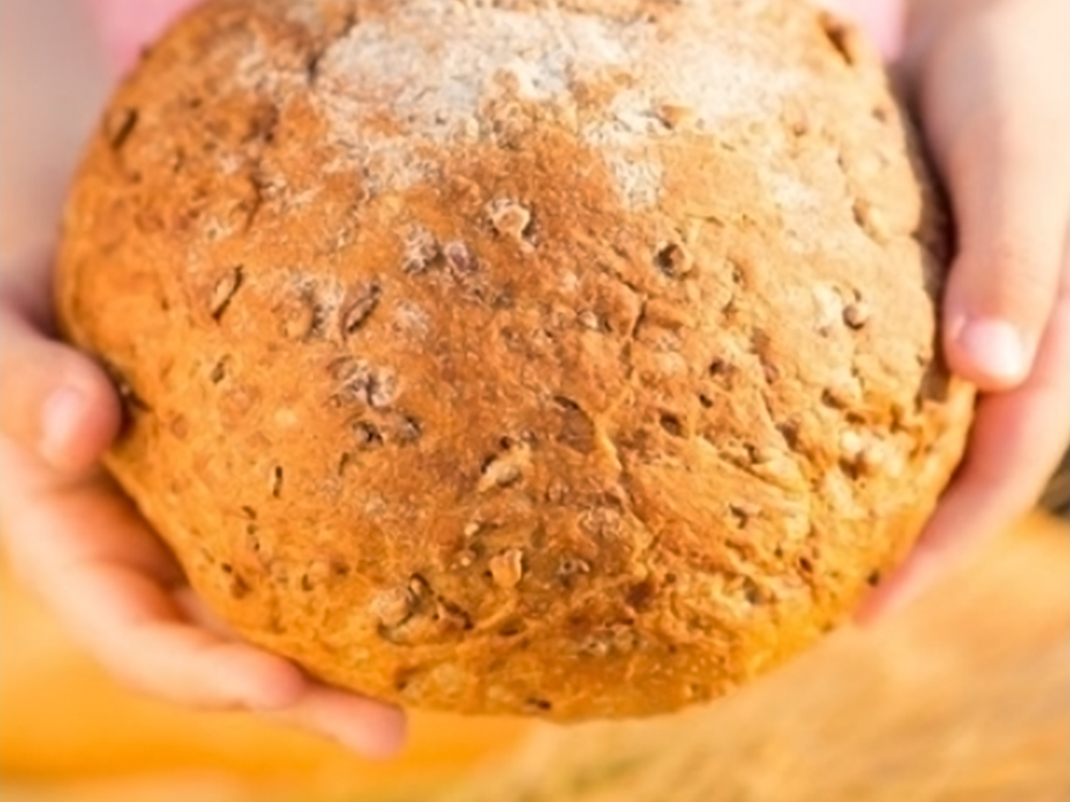
Share :
Whole grain foods
Note: It’s best to cover the Lunchtime fun! module before starting this one.
Whole grain foods are delicious and, along with other foods, they provide us with the nutrients we need to grow, learn, and play. Wheat, rice, corn, and other whole grains can be prepared and enjoyed in many different ways. Canada’s Food Guide encourages us to eat whole grain foods. Studying the different parts of a grain of wheat or rice can help students understand what we mean by “whole” grain.
Curriculum links
- Health and physical education: Healthy living
- Science and technology: Life systems
Learning objectives
- Learn about whole grain foods
- Discover the parts of a grain of wheat or rice
- Understand the difference between whole grain flour and all-purpose white flour
Learning methods
- Looking at samples of whole grain flour and all-purpose white flour and comparing their characteristics
- Looking at grains of wheat and rice and comparing their characteristics
Materials
- 250 mL (1 cup) whole wheat flour; use brown rice flour if there are children with wheat allergies or celiac disease in the class
- 250 mL (1 cup) all-purpose white wheat flour; use white rice flour if there are children with wheat allergies or celiac disease in the class
- 125 mL (½ cup) red wheat grains (sold in natural food stores and some grocery stores)
- 125 mL (½ cup) white rice grains
- 125 mL (½ cup) brown rice grains
- 1 slice white bread
- 1 slice brown bread
- Sheets of white paper
- Magnifying glasses (one for each student)
- Illustration showing a cross-section of a grain of wheat or brown rice
- Fine-mesh metal strainer (optional)
- Medium size mixing bowl (optional)


Introduction
Pre-activity: Class discussion
- Tell students that they will be exploring whole grain foods today. Ask them what they think of when they hear “whole grain.”
- Do certain foods come to mind?
- What are some of their favourite whole grain foods? Since there are so many different whole grains, there may be a wide variety of answers: wheat, quinoa, oatmeal, bread, rice, tortilla, pita bread, bagels, corn, popcorn, pasta, cereal, barley, buckwheat, etc.
- Why do you think these foods are considered whole grain foods?
- These foods come from plants that produce a kernel or a seed. We can eat the entire kernel, or seed, from these plants. We can cook and eat the kernels whole or we can transform them into flour that we use for baking.
- Show students a grain of wheat and a grain of brown rice.
- Explain that both kernels belong to the grass family. Wheat and rice are known as cereals. Cereal plants are grown in large fields and are harvested by farmers.
- The kernel produced by a cereal plant is known as a fruit. These fruits are small, hard, and dry, and look nothing like apples, pears, and strawberries, which are fleshy and juicy fruits.
- Ask students how grain from cereal plants becomes flour.
- The grain is milled, which means ground into a powder, or flour
- We mix the flour with other ingredients to make foods such as bread, pasta, and tortillas
- Explain to students that the activity that follows will help them distinguish between foods made from whole wheat flour and those made from all-purpose white wheat flour.
Activity: Whole wheat flour versus all-purpose white wheat flour
Before starting: Prepare observation stations
- Prepare an observation station, using desks or small tables, for each group of 3 or 4 students.
- Put a magnifying glass for each student at the observation station, as well as a sheet of paper in the centre.
- Pour a little all-purpose white wheat flour (or white rice flour) and a little whole wheat flour (or brown rice flour) onto the sheet of paper at each observation station. Make sure the piles are separate so that the two types of flour do not mix.
- Pour a few grains of wheat and a few grains of white and brown rice onto the sheet of paper at each observation station. Make sure the piles are separate so that the three types of grain do not mix.
Warning: Uncooked flour may be contaminated with harmful bacteria such as E. coli. After conducting this experiment, have the students wash their hands with warm water and soap, and wash all surfaces and objects that were in contact with the flour.

Instructions
- Divide the class into groups of 3 or 4 students. Assign each group to an observation station.
- Show students the illustration of a cross-section of a grain of wheat or brown rice (See printable PDFs below).
- Explain that this is what the inside of a grain looks like. Inside each grain is a baby plant, known as a germ.
- This tiny germ stays dormant (sleeping) until its environmental conditions allow it to wake up and germinate, or grow. Inside the grain, endosperm (or albumen) gives the germ the nourishment it needs to stay alive while it sleeps.
- The hard shell is called bran. It is a thick coating that protects the germ from harsh weather conditions (rain, snow, and freezing temperatures), mould (fungi), and predators (insects, mice, and birds).
- Bran acts like a house or a warm coat for the germ. When the conditions are right, the bran softens and the germ starts to grow.
- The grain of wheat or brown rice germinates and becomes a plant. At first, it has no roots or leaves. It feeds on the endosperm until it develops leaves to produce its own food, and roots to take in water and nutrients from the soil.
- Have students look at the whole wheat or brown rice flour through their magnifying glasses. Explain that this flour is made from the entire grain. All parts of the grain are milled: the germ (which is beige), the endosperm (which is white), and the bran (which is dark brown). All these parts of the grain help our bodies function, help us feel good, and help us to live well.
- Have students look at the all-purpose white wheat or white rice flour through their magnifying glasses.
- What do they notice?
- Do they see a difference between it and the whole wheat or brown rice flour?
- The all-purpose white wheat flour looks whiter and doesn’t contain any specks of beige (germ) and dark brown (bran). To make all-purpose white wheat flour, whole wheat flour is sifted to remove the germ and the bran. In white all-purpose flour, all that is left is the endosperm (or albumen).
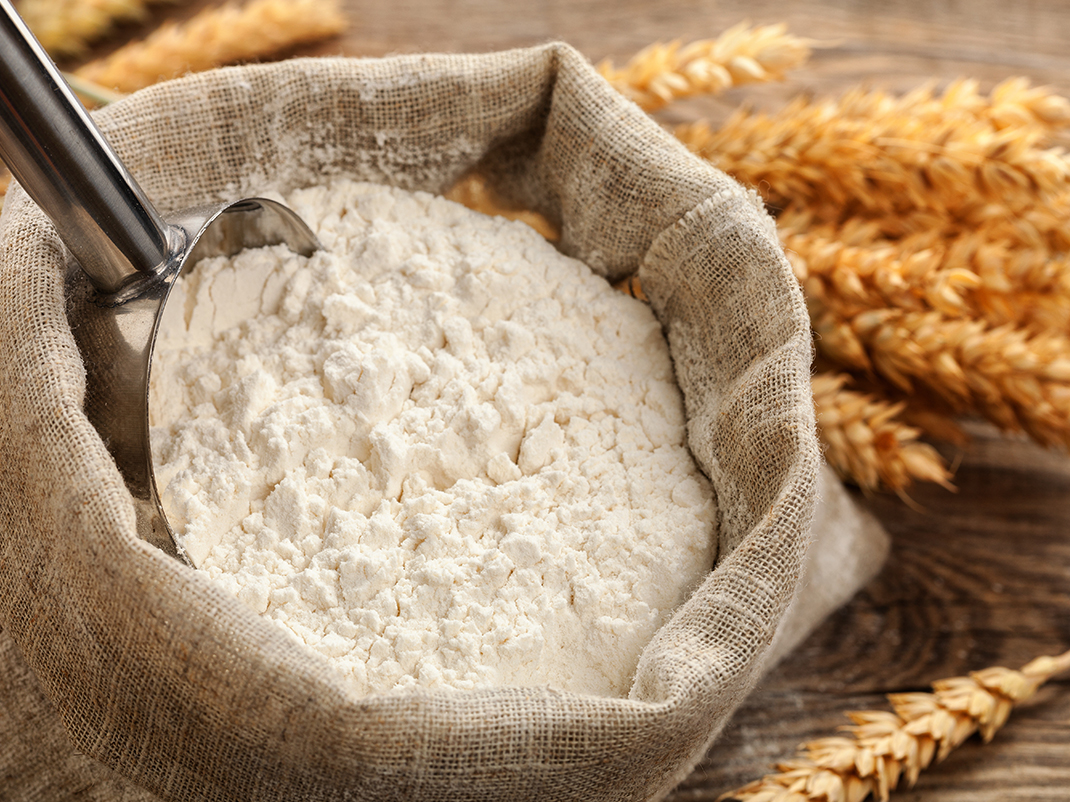

Optional activity
You can do the following activity in front of the class for everyone to see, or provide each observation station with one medium size mixing bowl and one fine-mesh metal strainer, and have the students conduct the activity in small groups.
- Place the strainer in the bowl and scoop 1 scant cup of whole wheat (or brown rice) flour into the strainer. Start sifting the flour into the bowl. The endosperm (white powder) will separate itself from the germ and bran. The endosperm will fall into the bowl while the germ and bran will remain inside the strainer.
- Show students the 2 slices of bread. Ask them to guess which type of flour was used to make the white bread and the brown bread. Students can use their magnifying glasses to see if they can spot specks of germ (beige) and bran (dark brown) in the brown bread.
- Have students look at the grains of rice through their magnifying glasses. Why are the grains of rice brown or white? Brown rice is a whole grain. It contains all the parts of a grain of rice. White rice has had the bran and germ removed, and what’s seen is the endosperm that’s left.
Wheat cross section
Please see the printable PDF at the bottom of the page.
Brown rice cross section
Please see the printable PDF at the bottom of the page.
Canadian grown grains
Many people eat whole grain foods daily. Can you name different types of grains? Which grains are most common in Canada? In this activity, students learn to recognize the most popular grains they are likely to come across every day.
Curriculum links
- Health and physical education: Healthy living
- Mathematics: Data processing and probability
Learning objectives
- Understand that most whole grain foods are made from a variety of grains
- Discover which grains are eaten most often in Canada, and where they are grown
Learning methods
- Identifying the grains listed as ingredients in various grain products, and creating a bar graph to illustrate findings
- Grouping packaged grain products by the types of grain they contain

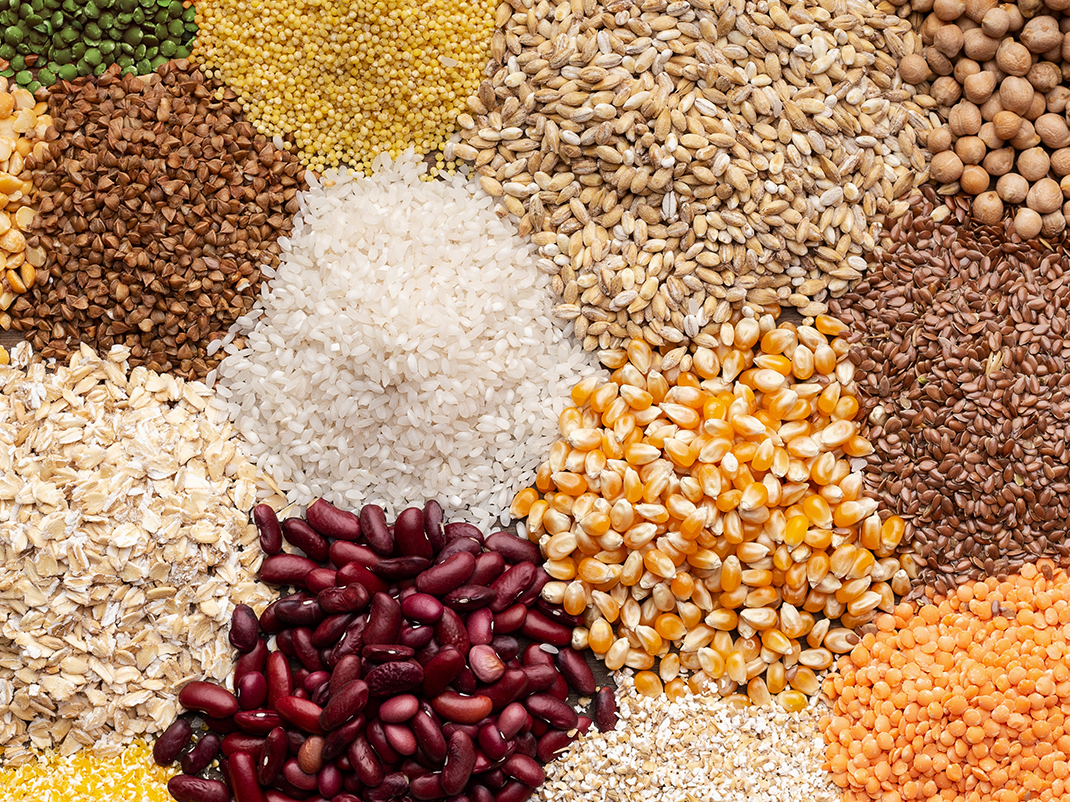
Instructions
Pre-activity: Class discussion
- Ask students to name grains they know.
- Are all grains the same?
- How do they differ (e.g., colour, size, shape, texture, and taste)?
- Can all grains be cooked in the same way? For example, can we make popcorn out of rolled oats? No! Each grain is unique in its taste, texture, size, shape, smell, and colour.
- To make them tasty, different grains are cooked in different ways. We can discover various kinds of grains by exploring different dishes and recipes.
- The day before the activity, ask students to find one food at home containing one or more grains.
- Ask them to bring the food, or just its packaging, to school the following day
- Give students examples of products they can bring: granola bars, crackers, tortillas, pasta, bread, or breakfast cereals
- Ask them to be aware of allergies and to avoid bringing products containing peanuts or nuts
Activity:
- Explain to students that they will be investigating to find out which grains are found in the foods they have brought from home.
- By creating a diagram with the data, students will be able to see which grains are used most widely
- Divide the class into small groups.
- Ask students to read the ingredients listed on the packages they have brought from home
- On a sheet of paper, each student then writes down what their food is and the type or types of grain they recognize among its ingredients
- Move around the room and spend some time with each group
- Reread the lists of ingredients with students, making sure they have identified all the grains included
- Once students have finished, collect the data.
- On the blackboard, draw a chart with 2 columns
- Ask each group to list the grains identified and record them in the left-hand column of the chart
- Name each grain recorded in the chart, one at a time.
- Ask students to raise their hands if the grain appears in the ingredients list on the package they brought from home
- Students should raise their hand for their own food, not those of their group
- For each grain, count the hands raised and record the number in the right-hand column of the chart
- Discuss the data collected.
- Review bar graphs with students, identifying the components a bar graph needs to include
- Then ask students to use the data collected to produce a bar graph showing which grains were found and how often
- Students can work individually to create their own bar graphs on paper, or in a group to create one bar graph on the blackboard
- Referring to the graph or graphs, ask students to identify which grains were the most popular.
- Which grains were the least popular?
- Are these grains familiar?
- What do they look like?
- Show illustrations of the various grains (using the Grain cards from the Global Grains activity).
- On a map of Canada, show the Prairies: southeastern Alberta, southern Saskatchewan, and southwestern Manitoba.
- Explain that the region is known as “Canada’s breadbasket” because of the great quantities of wheat, barley, and oats that are grown there
- Corn is grown mainly in southern and eastern Ontario and southern Quebec; show these regions on the map
- Corn takes much longer to grow. These regions have a warmer climate and longer summers than the Prairies.
Suggestion
Ask students to conduct their own investigations related to grains. They can ask questions that require multiple-choice answers.
- For example: Question: Which is Grade 3’s favourite grain? Answer: Corn (popcorn), oats (oatmeal), rice, wheat (pasta), or other
- Students then create a bar graph illustrating the results of their investigation
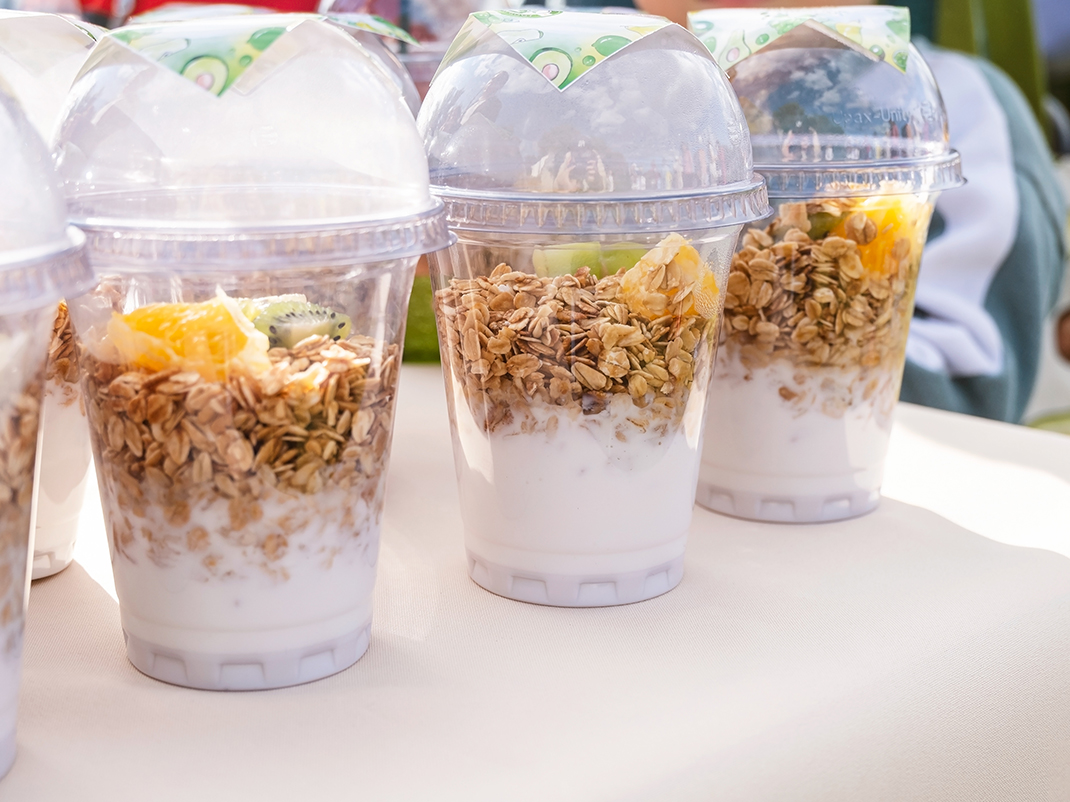
Global grains
Grains such as wheat, corn, rice, quinoa, amaranth, teff, and sorghum, to name just a few, are staple foods. Worldwide, most people eat grains every single day. All grains provide our bodies with the energy we need to function. But the grains people eat vary from one region to another, depending on their growing environment. This activity allows students to discover grains from all parts of the world, and to learn about the needs of plants.
Curriculum links
- Health and physical education: Healthy living
- Social studies
- Science and technology: Life systems
Learning objectives
- Become familiar with different grains grown around the world
- Understand that each grain plant has its own needs, which influence where in the world it can be cultivated
- Understand that different grains play a role in many different cuisines around the world
Learning methods
- Playing a matching game
- Conducting research on the Internet
Materials
- Photocopies of activity sheets
- Desert image
- Forest image
Before starting: Activity card preparation
Print the activity sheets, preferably in colour, on stiff paper. Each activity sheet features a Grain card and a Farmer card. Cut the sheets in half to separate the cards.

Instructions
Pre-activity: Class discussion
- Ask students to list the needs of plants.
- They need water, light, soil to provide nutrients, and air to provide carbon dioxide
- Show the illustration of a desert and ask them to compare it to the image of a forest
- How are the two environments different? In water quantity, temperature, wind, soil, flora, and fauna.
- In which environment could we grow more food plants? In the forest, which has more water and richer soil: conditions that are more favourable for most plants.
- Do all plants have the same needs?
- Like us, plants have preferences
- Some plants need a lot of heat, while others prefer a cooler climate. Some plants need a great deal of water, while others need very little. Some plants can grow in very poor soil, while others need soil that is very rich in nutrients.
- When a plant has everything it needs, it flourishes. A plant may survive in an environment that meets only some of its needs, but it will not be healthy and it may not produce much grain or fruit.
- Some plants grow very well in all environments, while others can only survive in certain places.
- This is why maple, spruce, and pine trees flourish in Canada’s forest regions, and why cactus do well in the desert.
- Spruce trees grow in the north, where it’s cold; palm trees grow in the south, where it’s hot. Give students some other examples.
- Ask students to imagine life in a distant country on another continent.
- In that country, do people eat the same foods that we eat in Canada?
- Would children there have brought the same grain products to class for the Canadian-Grown Grains activity? No, because in different regions of the world, people eat grains that are adapted to their environment, that is, grains that grow well there. People in that distant country don’t usually produce food from the grains we grow in Canada.
- Explain to students that we will find out which grains are important to different groups of people around the world through the next activity.
- Their task is to match various grain plants with the regions of the world that best meet their needs
- They will also learn where the plants have become an important food source for local populations

Activity: Matching game
- Divide the class into small groups of between 2 and 4 students. Ask the groups to sit together on a carpet, at a table, or at desks.
- Explain that each group will be given a card. The information on the card must be kept secret. Students must not show their cards to other groups.
- Give each group a ‘grain’ card or a ‘farmer’ card.
- The Grain card describes the needs of a particular grain plant and the environment it seeks
- The Farmer card introduces a farmer who describes the environment where they live
- Ask each group to read the information on their card quietly. When they have done so, provide instructions about the game.
- Ask students with a ‘grain’ card to raise their hands.
- Explain that these feature grain plants that are looking for the best place to take root and grow
- Ask students with a ‘farmer’ card to raise their hands
- Explain that these show farmers who are looking for a grain plant that can be grown in their region and will provide food for their local population
- Explain how the game works.
- The groups move around the classroom, trying to find a match for the grain or the farmer on their card
- For a grain plant to flourish in a region, all its needs must be met, and so the farmer must indicate clearly what their environment offers
- When a grain and a farmer find their match, the two groups sit down on the floor together
- How do grains and farmers find their ideal match?
- Each time two groups meet (one with a ‘grain’ card and one with a ‘farmer’ card), they take turns asking each other yes-or-no questions
- The questions must reflect the information on the card
- For example, the group with the ‘rice grain’ card knows that rice plants flourish in a hot and humid climate, so it asks a group with a ‘farmer’ card: “Is it hot in your region?”
- The farmer group checks its card, which represents the Niger region, and answers: “Yes”
- Next, the farmer group asks: “Can you live in a place without a lot of water?” The grain group checks its card and sees that rice plants need a large amount of water, and so answers: “No”
- These two groups keep on looking for an ideal match. Remember: groups must not reveal their identity before asking questions.
- Begin the activity and move around the classroom, helping the groups and reviewing how the game works, as needed.
- When all the groups are sitting down, ask them to announce their grain-and-farmer pairs and explain how they made their matches. Once all the groups have spoken, ask students if they are sure that all the grains have found the right farmers. Change up the pairs, if necessary.
- Alternative 1: If groups have trouble making the matches by asking questions, have them try comparing the information on the ‘grain’ and ‘farmer’ cards
- Alternative 2: Give each group a copy of all the cards. Ask groups to compare the information on the cards and to match ‘grain’ cards to ‘farmer’ cards, setting them side-by-side on the table.

Suggestions
- Have students look at a world map or use Google Earth to find the regions described on the ‘farmer’ cards
- Create a list containing a variety of different grains. Have students use the Internet to research up to 8 recipes (or one recipe per group) featuring a grain they have chosen from the list you created. Have them format the ingredients and instructions, and include an illustration
- Compile their recipes into a booklet (electronic or print format) and give each student a copy.
- Ask students to prepare a short presentation on the lifestyle and cuisine of a people from another part of the world. They should highlight how a specific grain is used by this group. Examples include teff in Ethiopia, kasha in Ukraine, millet in Niger, amaranth in Mexico, and quinoa in Peru.
- Create a list of various regions in the world. Ask students to choose one region of the world, and find a traditional recipe from that region. They should prepare a short presentation that includes a map showing where the recipe comes from and highlights which grain it uses, along with other relevant information.
Global grains
Please see the printable PDF at the bottom of the page.

Printable PDFs
Wheat cross section (PDF, 636 KB)
Brown rice cross section (PDF, 285 KB)
Global grains (PDF, 4.9 MB)
You may also be interested in

Healthy kids quest: Water for me, please!
Feeling thirsty? In the Water for me, please! module of the Healthy kids quest, students will learn that water is essential to our survival. When we make water our main drink of choice, we satisfy our thirst and feel good.
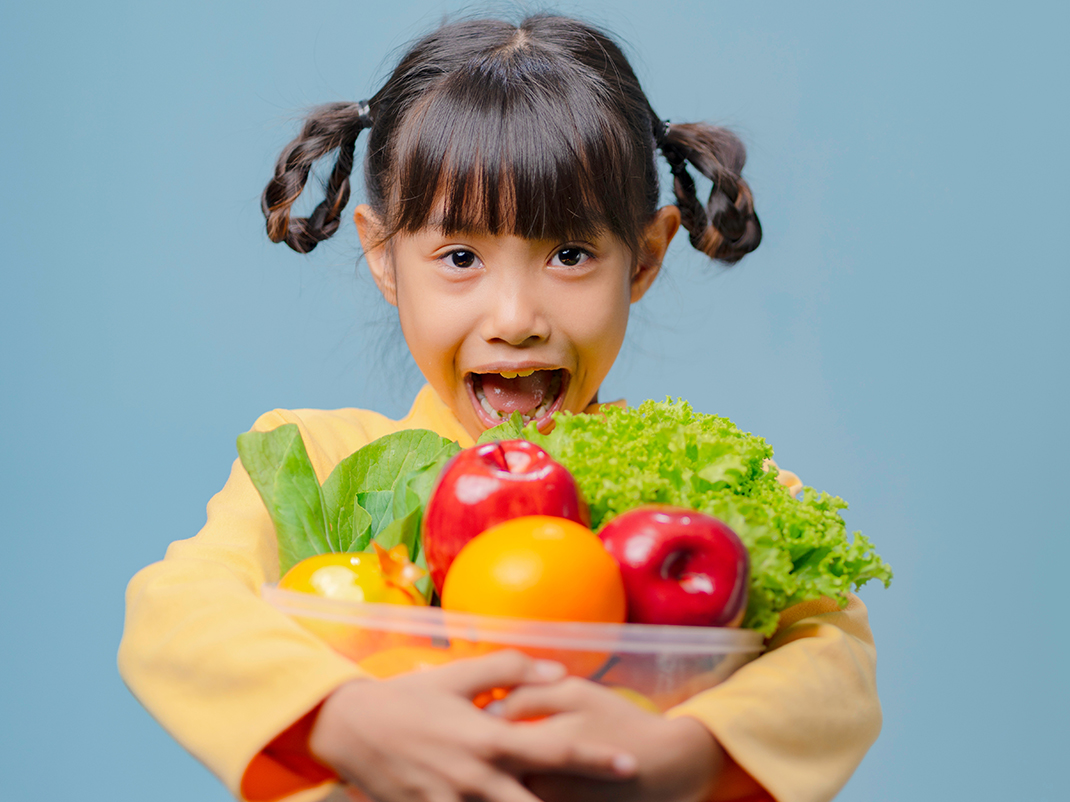
Healthy kids quest: Vegetables and fruits
Vegetables and fruits form one of three categories of foods that Canada’s Food Guide recommends we consume regularly. In this module of the Healthy kids quest, kids will learn about a wide variety of vegetables and how they help our bodies function so we can grow, learn, and play.
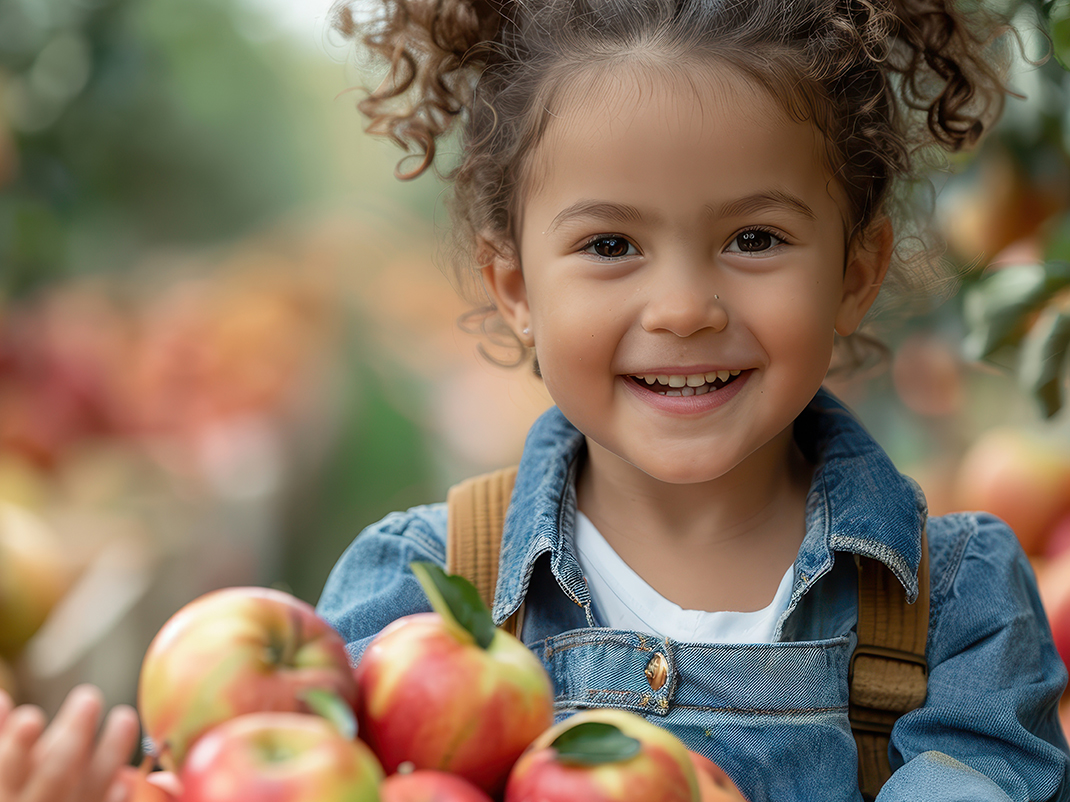
Healthy kids quest: Memorable meals
Food helps our bodies function, but it also gives us an opportunity to enjoy ourselves, as we spend time with others in our families and communities, and connect with our culture, traditions, and history. This module encourages students to discover or look deeper into their family recipes and traditions.